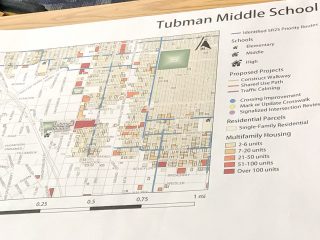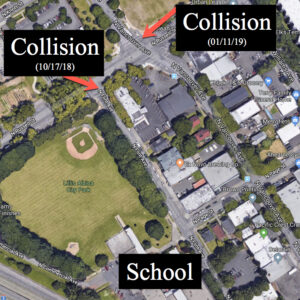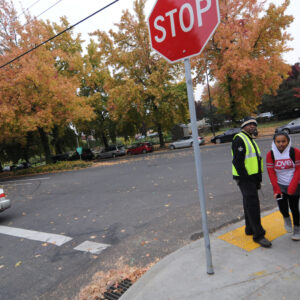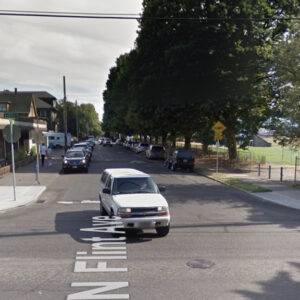
(Photos: Jonathan Maus/BikePortland)
“We believe kids coming to this school need an elevated skillset to navigate these streets.”
— Dana Dickman, PBOT
This is the meeting that should have taken place before two students where hit.
On Tuesday, Harriet Tubman Middle School officials and bureau of transportation staff met with parents who are concerned that their children will be run over by automobile users while walking and biking to class. Tubman sits on Flint Avenue, a busy driving route that’s the main access to the Broadway Bridge. One block northeast is the wide and fast intersection of North Russell Avenue and Vancouver. Interstate 5 — and all its associated hazards — is literally in the school’s backyard.

Traffic safety concerns were on the table before the school year started. When a girl was hit on her way to school while walking in a crosswalk in October, parents raised their voices even louder. “Everyone’s afraid their kid is going to get hit,” parent Jillian Wieseneck shared when I met her outside the school a week later.
Then it happened again. On January 11th, another student was hit while trying to cross the street just one block away from the previous collision and two blocks away from the school’s main entrance.
Tubman, formerly an all-girls school, closed in 2012 due to low enrollment. It then served as temporary home for a different school before re-opening last fall.

Advertisement

“From a racial perspective, when our kids of color, specifically black kids, see a policeman, that affects them.”
— Lavell Wood, Tubman vice-principal
Lavell Wood is Tubman’s vice principal. At the outset of this week’s meeting he stressed that the newness of Tubman has added to safety challenges. “In terms of transportation,” he said, “When Faubion was here it was short-term. But now we’re here for good and things that worked for Faubion may not work for us.” Wood was happy to see parents in the room and added that, “We want to hear from you, because this is so huge we can’t fix it ourselves.”
While he’s grateful for parent participation, Wood said he wanted to make sure everyone was, “Keeping race and culture on the table.” He said he’s heard some parents want police to direct traffic during morning drop-off (an idea that didn’t come up during the meeting). “From a racial perspective, when our kids of color, specifically black kids, see a policeman, that affects them. Will it be stopping them from coming into the building and being ready to learn?” Wood also reminded attendees that the school is located in what used to be a “thriving black community” and he encouraged everyone to find ways to bring more voices to the table.
The Portland Bureau of Transportation had three staffers in the room: Traffic Safety/Safe Routes to School Manager Dana Dickman (a planner), Lale Santelices who’s on the Safe Routes community engagement team, and spokesman Dylan Rivera.
Dickman helped lead a year-long Safe Routes planning process that delved more deeply into conditions at all public schools. Part of that process, she said, was talking to community leaders and parents about specific concerns with getting to school. But that didn’t happen at Tubman. “We couldn’t to that in advance of Tubman,” she explained, “Because we didn’t actually know what those routes were going to be. It was hard for parents, the summer before they’ve ever been here, to know what those routes would have looked like and where they thought their kids would go.”
Tuesday’s meeting was a chance to play catch-up. Dickman asked parents to help identify, “primary investment routes.” She also added a note of caution, perhaps not wanting to disappoint anyone who thinks a few infrastructure fixes and student education programs will solve the problems.
“You’re dealing with a more urban context than many other neighborhoods,” Dickman explained, referring to the traffic conditions in the area. “It is very intense. You have emergencies coming to the hospital [Legacy Emanuel and emergency room is just a few blocks away], there are lots of places funneling onto the freeway [the school backs up to I-5], you have a very constrained situation. Even with improvements, that constrained situation is still going to be there.”
Dickman then said because of that, educating students should be a top priority. “We believe kids coming to this school need an elevated skillset to navigate these streets — even more so than other neighborhoods. And we want to help provide that.” Dickman warned the parents that even with great infrastructure, bad things can still happen. “We have a significant issue with pedestrian crashes in Portland and almost half of them happen at signalized intersections. So even in places where we think we have the safest infrastructure, we’re still having challenges and conflicts.”
Teaching middle schoolers about traffic safety is no easy task. Vice Principal Wood said only two students have signed up for the school’s crossing guard club so far (someone suggested a party and/or prizes to help sweeten the deal).
“There’s so much traffic calming on Vancouver for the hospital. There should be as much — or more — for our kids.”
— Joan Petit, school parent
While there was a lot of talk about student education, the role of parents was also discussed. Dickman and her staff have observed conditions during drop-off and pick-up and have noticed that parents, “have some challenges following rules.” Parent Joan Petit added that, “We need parents dropping off kids educated as much as we need our kids educated.”
A few parents who ride bicycles suggested that bicycle riders avoid the area by staying off Flint Ave and continuing south Vancouver until Tillamook. One parent (whose name I didn’t get), said, “I bike down flint. And I’m part of the problem, not the solution!” Then she added, “Stop biking down Flint unless you’re dropping a kid off!”
Joan Petit, another parent who bikes daily and agrees avoiding the two blocks of Flint in front of the school is a good idea, would like to see Flint no longer be a designated driving route to the Broadway Bridge. The problem with that however, is Flint is considered the only feasible route because it’s illegal to turn right (west) off Vancouver onto Broadway. And if PBOT directed drivers past the school and onto Tillamook (to avoid most congested area of Flint), they’d be putting more cars onto an important cycling route (Tillamook is a neighborhood greenway).
When asked why Flint can’t be closed to through auto traffic, PBOT didn’t sound too enthusiastic. Safe Routes staffer Lale Santelices said they could explore the possibility, “But that would be a bigger lift.”
Beyond finding a way to move traffic (driving and biking) off Flint, there seemed to be a consensus that more signage is needed to let people know that Flint between Russell and Tillamook is a school zone. “People are driving on Russell and Vancouver like it’s an arterial. You can’t tell there’s a school nearby,” said Petit. In her mind, the school deserves the same traffic safety attention that Legacy hospital has received. “There’s so much traffic calming on Vancouver for the hospital,” she said, “There should be as much — or more — for our kids.”
One of main takeaways of the meeting was a productive session of poring over a large map and comparing notes and feedback on various routes and hot-spots.
With talk of which routes where good/bad, safe/unsafe, parent Katrina Yuen shared a lament about what we require people to know simply to ride a bike. “You have to know not to ride a bike on Flint or on MLK, but that’s a lot for people to keep in mind. Ideally, in a cycling city, you shouldn’t have to know which roads to ride on.”
While there’s no major progress to report, the meeting was a step forward. Tubman’s PTSA now has a transportation safety subcommittee (this was its first meeting), priorities are taking shape, and relationships are being built around these issues. If you’d like to get involved or share your perspective, contact Vice Principal Wood at lwood@pps.net or PBOT at saferoutes@portlandoregon.gov.
— Jonathan Maus: (503) 706-8804, @jonathan_maus on Twitter and jonathan@bikeportland.org
Never miss a story. Sign-up for the daily BP Headlines email.
BikePortland needs your support.







Thanks for reading.
BikePortland has served this community with independent community journalism since 2005. We rely on subscriptions from readers like you to survive. Your financial support is vital in keeping this valuable resource alive and well.
Please subscribe today to strengthen and expand our work.
Yes, Dana, let’s “elevate the skillset” of the 11 year olds so that they stop getting hit in crosswalks. Much more effective than making real change that might slightly inconvenience people.
Insanity.
“this is so huge we can’t fix it ourselves.”
Automobility for you.
SRTS does not have an unlimited budget nor the power to make whatever infrastructure changes they want. The real problem is city/state funding, the will to do something with it, and transportation guidelines and laws that block much of what you might want to do. SRTS can advocate for infrastructure changes, or enforcement, or education, but there’s very little that they can magically make happen without bureaucratic signoff and community buy-in.
That is a truly awful quote and not even remotely consistent with Vision Zero. I’m at the point where I’m sick of seeing the city even mention Vision Zero. It’s been turned into a useless platitude.
We are discussing the safety of children trying to get to school without dying. And the response from the City is that these pre-teenagers just need to be a little bit smarter. What a joke
MTW,
The joke is that most people are unaware of what Safe Systems is all about. It’s not about eliminating crashes.
It requires action from multiple points of attack, not just infrastructure, but also road users. Since no one can afford separated paths for all users, most users will have to interact at some time on the system. Smarter interaction, defensive walking, biking and driving, are sound parts of the puzzle.
“Smarter interaction, defensive walking, biking and driving, are sound parts of the puzzle.”
Or you could do what the Vision Zero* folks do which is focus on the evident menace, which would work pretty well in this case too.
*Swedes, Australians, NYers, SFers, etc., those jurisdictions which understand which side their toast is buttered in.
It’s incredibly disappointing to see how the city has re-fashioned vision zero to fit its motorist-centric prejudices.
From “humans make errors” to “defensive walking”.
https://www.who.int/violence_injury_prevention/publications/road_traffic/world_report/en/
Especially disappointing when later in the article the poor driving behavior of parents at drop-off is mentioned.
I think if you read her quote in the context she said further down in the article, rather than in this inset box it makes a lot more sense. She’s talking about how this location is more complex than many other school locations, and how instruction and skills are needed in addition to infrastructure. in the same sentences she says-
“We have a significant issue with pedestrian crashes in Portland and almost half of them happen at signalized intersections. So even in places where we think we have the safest infrastructure, we’re still having challenges and conflicts.”
Isolating this one sentence seems like a juicy, but less-than-fair representation of what she said. This doesn’t help build any trust between BikePortland readers and the staff at PBOT.
Hi John,
I don’t think we should make policy decisions like this based on a freeway expansion project that might never happen and even if it does it is still many years away.
If the CIty’s position is that this street needs to stay open, assuming for through-traffic, shouldn’t they be opposed to the project that will eliminate the connection to the south?
I believe that the project makes up for removing the flint crossing by realigning to Dixon-Hancock. PBOT’s probable stance is that one or the other is needed.
https://i5rosequarter.org/hancock-dixon-crossing/
The school also has a rear driving area that connects from Flint to a driveway at Commercial. Another potential drop off pathway.
So Faubion is a neighborhood school about four miles from Tubman. The Faubion kids who were attending Faubion at Tubman temporarily were not coming from within the Tubman area, so they were either taking the bus or getting dropped off. Right now, many Tubman kids are walking or biking to school. It’s a very different situation.
Yes, exactly, I think it was different when kids were only getting to school in a bus or family cars. There’s a lot more active transportation now. And, yes, we folks on bikes need to re-train ourselves to stay on Vancouver to Tillamook and avoid the Tubman part of Flint. Still, I’ve ridden down Vancouver and seen cars not stopping for Tubman kids trying to cross Vancouver to get to school. They’re not looking or they’re ignoring them. It’s not traditionally been an area with heavy pedestrians, and our kids are vulnerable users. There are definitely some infrastructure changes that could make a big difference here.
I can confirm that the Faubion drop off was behind the school, via Commercial. Stopping to drop off or pick up kids was not allowed on Flint and the crossing guard (a teacher) and administrators enforced that rule. And while many of the kids came by bus, there were still some parents that biked with our kids there every day.
This is a really important point. It’s just crazy to me that schools let parents create a crazy car-traffic concentration at exactly the spot where there are the most kids walking or biking to school. Simple logic leads me to believe that the risk parents driving pose to kids walking and biking is MUCH reduced if parents driving don’t cluster at the same place where kids walking and biking do (just due to a reduction in exposure – fewer people driving in the same space with a bunch of kids walking and biking means fewer opportunities for crashes).
This is why, when our elementary school lost half of its buses, I gave a presentation to the sshool leadership, BSD, and concerned parents on the idea of ‘alternative drop spots’, with a map of suggested places to drop children off BESIDES the school lot. My map had 13 different locations, some of them up to 1/2 mile away, and all of them were set up to allow the parent to drop their child off on the right side of the vehicle and then drive away towards the left (to reduce conflict points), where the kids could walk on a safe route to school.
I don’t know if it helped ANYBODY, but I know my son regularly has to cross a road on his way to school that is clogged with parents driving their kids past our house. Seems to me they could easily stop in front of our house and let their kids walk the same route that my son does. It seems absolutely crazy to me to try and drop somebody off in a school lot when you could just as easily and safely do it from a couple of blocks away.
Thanks so much, Jonathan, for coming to the Tubman meeting on Tuesday night. It’s great to have your attention and reporting on this issue. While I was glad to have the meeting with PBOT, I do wish they had come sooner. These safety issues feel urgent. I’m convinced of PBOT’s sincerity, but I’m concerned we are going to have more kids hurt before they can implement some of these changes.
We could try ENFORCEMENT.
We’ve determined that we don’t have enough money to implement every infrastructure fix.
Other countries and communities use enforcement; maybe we should give it a try.
Nope, the VP already made clear they don’t want cops around. The parents are really to blame here…they all drive!
Speed bumps. 330 of them for the price of one traffic signal.
Studying which street to make “the” safe route to school is not the answer. I was at a meeting recently where the discussion went from the scripted question of “which streets (in NW Portland) should we make safe” to “hey that’s not fair to folks on the other streets” to “why shouldn’t everyone’s street be safe?” Good question.
Everyone’s street cannot be safe instantaneously in a world with limited resources for improvement and infrastructure lifespans that are 20-40 years in length. It will take time to improve all infrastructure, especially at current spending rates with ever increasing maintenance costs from aging infrastructure. The prudent course of action with limited resources is to focus on improving key routes then expanding access to safely feed those routes.
Speaking of safety improvements, ODOT has a neat-o plan to add additional merging room on a small section of I-5 to reduce fender-benders between people who don’t know how to merge. Only $500 million, if they stay within budget.
Just curious – why is biking down Flint part of the problem? Driving, yes; but why biking?
Because some bike riders are rude and selfish and they are hazardous to others.
I’m curious if there were discussions about how to limit bike commuter traffic on Flint without impacting the ability of children who bike to school. (Speed bumps?)
(I agree that cycling commuters are often rude and selfish — and especially so around pedestrians.)
I wonder if they could try some simple interim measures like some big sandwich board signs approaching the Vancouver /Russel intersection that say “For Flint Bridge, bikes continue to Tillamook” and then another board at Tillamook that has an arrow and “Flint Bridge Access”.
I would guess most cyclists wouldn’t mind the detour since you don’t actually bike any further and avoid the cluster- it probably just hasn’t occurred to folks to go that way, or they forget as they are biking on auto-pilot. I usually go straight down Vancouver toward the Moda Center, but when I am headed to Broadway Bridge, it had never occurred to me to connect via Tillamook instead of Russel. Also, the behind the school drop-off seems like some good low-hanging fruit approach to test with parents.
There are already signs posted with such a message. I see them every time I go past the school. I do not see any students, buses, or crossing guards because at my commute times (before 8, after 5) they are never present. I’m perturbed that we are talking about regulating bike use to fix a problem readily identified with the near-hegemony of car operation on our streets but if the city wants to build a wall across Flint in front of the school I can deal with it.
Fair enough, I never bike by the school during school/commute times so i assumed from the post that it was an issue. That said, it seems like such signs would be more effective on Vancouver than on Flint where riders are only seeing them after they’ve turned onto that roadway. All in all, I agree with your comment that the bigger issue seems to be with vehicles, likely parent drop-offs.
Maybe the police could do a bike sting near Tubman when they are done at Ladd’s.
How many students have been injured by cyclists so far? I have heard of two motor vehicles hitting students, but have not heard of any cyclists doing so.
C’mon, Jonathan – I know there are selfish cyclists out there, but you can’t equate a 200-lb object moving at 15 mph with a 2000-lb object moving at 25 mph or more. I see this kind of false equivalence all the time in conversations about safety, and we need to call it out.
I’m not equating the two Fred. I’m saying that people on bicycles can be a threat and nuisance. I never said they are as big a threat as people in cars. That’s called being honest. That’s not a false equivalence.
Are you overcompensating in an attempt to be fair? A bike ridden under control is very maneuverable and the rider has a very strong personal motivation to avoid contact with anything because one of the early lessons learned about riding a bike is, contact with anything makes you crash. Crashing hurts memorably.
A bike ridden out of control most likely crashes, shedding its relatively small momentum. A car driven out of control maintains considerable momentum for a great distance and may even speed up if a panicking driver presses the accelerator. This is a thing that happens, unfortunately.
Bikes moving through a crosswalk are not as hazardous as cars and they are not even the same kind of hazard. It’s like comparing a person in shoes and shorts to a tank. Of course you know about this stuff, having ridden a million miles or so. Give yourself a break!
Cars have not weighed 2,000 lbs for twenty-five years, and even the it was an exception. If you are looking for a round number 4,000 is a lot closer.
Just saying.
As a cycling/walking resident of inner N/NE, I see *a lot* of cyclists that disregard crosswalk laws.
There is more irony here than any Alanis Morrisette song could hold. First off, at least in that photo, every parent except maybe one is Caucasian . And of course they want cops to come out and “direct traffic”. Because that’s what white, middle class people want. More cops. Because, you know, cops protect the middle and upper class primarily. Thanks goodness the guy in the room mentioned that.
Next irony, they (including the parents in the room) ARE TRAFFIC. THEY ALL OWN CARS. And oh by the way, I bet every single one of them drive like they own the road at some point. How is that possible, because they own cars.
The solution is obvious. Narrow the road to the point where anyone who doesn’t have to be (at least in there head) won’t go down the road. It’s quite simple really. Everyone knows it, nobody will say it…even the soccer moms and dads in the room…
With their cars. The couches that take them everywhere.
The best part? Some characters are grousing about the “rude bikers”.
Oh yes, how many bikers have killed 30K-40K people including many children? But let’s make sure the evil bikers make an appearance in order to make the car drivers feel better about themselves.
There are more ironies…but I will stop there.
Perhaps the post wasn’t clear… No one in the meeting asked for more cops to direct traffic. No one. The VP was telling people about OTHER conversations he had previously with other parents.
Much ado about nothing.
As a self-identified bike user who sometimes walks out for a six pack, I’ve seen plenty of just plain rude actions by other bike-ish people but none of those encounters felt like an existential threat, and none of the bike folk felt called upon to tell me to watch where I was walking. Legally.
Cars pushers not so much. Love those little bike logos on your license plates, BTW. Nice rack.
Would a crossing guards program be helpful in any way? Or does the school already have one?
I’ve passes through there a couple of times when students were leaving school and saw an adult crossing guard at the marked crossing of Flint where it Ts into Russell Street. There are cones beside Flint where buses park, signs, and generally an active effort by the school to support safe passage for everybody. A person could not possibly fail to notice it is a school zone.
A crossing guards program would be fine..